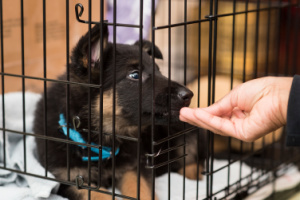Day One

Our first priority for puppy Chewy is potty training. At 13 weeks of age, he can control his bladder for an hour or longer during the day. His breeder has already started to potty train him, and thankfully, acclimated him to a crate. Our job is to further that training.
Puppies that have learned to tolerate confinement are easier to potty train. They don’t chew up your shoes or furniture. Your puppy won’t be living life in a crate, though — the crate is a place for rest, like a crib or bed.
Puppies will be crated at other times in their lives — at the vet or groomer, or during an emergency. If you travel, a crate may be required by the hotel or rental you choose. Learning to use a crate is a life skill, like wearing a collar.
When he first arrived, Chewy was held, walked, and given water. We took photos of him, tickled his tunny and presented him with toys. We tried to hand feed him pieces of kibble in preparation for training (he didn’t understand, probably because he was used to eating out of a bowl). Then it was time to give him a break.
We put Chewy in a 22 inch crate, just big enough for him to lie down in. He cried and fussed for a few minutes. However, he settled quickly, and fell asleep.
With young puppies, this routine continues. They come out of the crate for enrichment, socialization, stimulation, and play. They go back in for rest. When they come out, they are taken on a walk to go potty. This way, the puppy’s life develops a rhythm and his body adapts to the household schedule.
Some puppies do better with the crate in the family area; others appear to prefer the quiet of another room. We place a crate in each area for convenience and make a decision based on each puppy.
As tempting as it is to fill a crate with blankets and bedding, we don’t. Some puppies soil anything soft, and our goal is potty training. We’ve also noticed that dogs push bedding to the side, preferring to lie on the crate’s cool tray.
